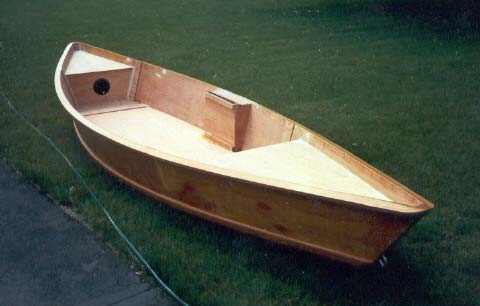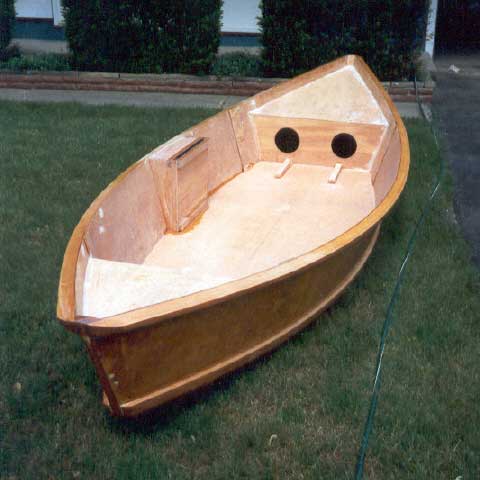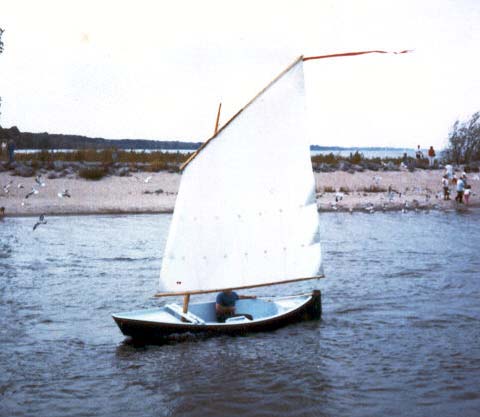|
|
Building
and Sailing a Bolger Windsprint
By Jack F McKie
|
|
Background
Back in the late 1980s I wanted a sailboat to get back on the
water that is so abundant here in Western New York State. I wanted
a sailboat that was easily single handled but would also carry
a passenger. I couldn’t afford to buy a new wood boat and
didn’t want a used fiberglass boat. I decided that the best
option was to build a boat since I am fairly adept at woodworking.
Having read Payson’s “Instant
Boats” and “New
Instant Boats” I decided to build Windsprint
primarily because of the double ended design and simple no lofting
construction. At the time I was leery of the offset daggerboard
and lug sail but decided that I liked the look of lug sail and
decided that in principle the offset daggerboard would work. I
sent to H.H. Payson for plans and to Bohndel for a sail. I bought
the sail first in order to have everything I needed in advance
as well as to pressure myself into completion of the project.
The plans arrived with the sail following shortly.

Building
Once the plans arrived it was easier to see the plan detail. One
concern I had was that I felt there was a need for floatation
in case of capsize. I drew in the flotation tanks fore and aft
on the plans and decided to add them. As it happened, they were
to be a welcome addition in the future.
Having been around boats in the
past I “knew” that I needed top quality wood. I managed
to find some clear douglas fir two by fours that would be used
for the chines and rails as well as some fir marine ply. For glue
I decided on West™ epoxy. The few fittings required were
either purchased or made. The only fastenings used were a few
brass screws and bronze ring shank boat nails.
To begin construction I cut all
the plywood parts per the drawings. This went relatively quickly
using a circular saw and table saw. Next, I ripped the chines
and rail laminations from the douglas fir two by fours on the
table saw which was a fairly lengthy and dirty process. Once all
the parts were cut out (except the flotation tank parts) I was
ready to start assembly.
First in the assembly process
was to make up the sides with their butt joints. I considered
scarfing the sides but decided to stick with Bolger’s design.
Once the sides were made up and the stems ripped out of fir the
assembly was ready to begin in earnest. Assembly goes pretty much
as described in Dynamite Payson’s description of building
Teal in “Instant Boats” but on a slightly larger scale
with more joints. One exception to this is the laminated rails
which are fussy to laminate but not difficult. I used epoxy throughout
building this boat including coating the ply with resin. Once
the basic hull was built and set bottom down on the garage floor
it was time to build the flotation tanks. I penciled in the location
of the tank tops and bulkheads deciding to place the tank tops
below the shear line in order to allow grabbing onto the rail
all around the boat. The aft bulkhead was located at the aft edge
of the butt joint while the forward bulkhead had to be located
just forward of the mast step and mast partners. One by two fir
was used to frame in the tanks with bevels being determined with
the use of a batten and bevel gauge. Patterns were made from the
framing and the bulkheads and tops were epoxied in place. The
following two pictures show the hull at this point having just
been washed prior to further construction and fitting out.


The first picture is looking forward.
The holes on the bulkhead are for Beckson™
screw type deck plates to allow access and storage. Storage in
the flotation tanks is limited due to the small six inch opening
but it is useful for odd lines, paddle, anchor, etc. Note the
level of the flotation tank top that allows one to grab the gun’l
at any point on the boat. At this point the hull was ready for
the aft thwart and mast partner as well as the daggerboard, rudder
and rig.
I built the mast partner as a laminated
piece to allow for a more simple design than shown in Bolger’s
drawing. The rudder and daggerboard were laminated from one quarter
inch ply per Bolger’s design though I made the daggerboard
one quarter inch thicker. Building the spars was not difficult
but finding the material wasn’t easy. I used clear spruce
two by fours ripped for the boom and gaff. I made the gaff and
boom an inch or two longer than the plans specify to assure the
sail could be set properly. The mast was hollow and built of Sitka
spruce as shown in the drawing. The biggest difficulty in making
the mast was clamping and making sure that the mast was straight
and true. I considered a solid mast but I had difficulty finding
suitable two by fours and felt the weight savings was worth the
effort to make the mast hollow. The box section mast Bolger designed
for Windsprint is probably the easiest hollow mast you
can build and is extremely strong. I glued many small triangular
blocks in place on the wide staves in order to locate the narrow
staves for glue-up.
Fittings on the hull are two bow
eyes, one being fitted to the top inside of the stem and the other
being at the bottom outside of the stem. The rudder was hung on
home made brass hardware machined from brass bar stock I mounted
two cleats on the sides of the mast for the halyard and one for
the downhaul. The sheet requires only one block mounted on the
rudder. I used chrome plated aluminum half oval strip for the
rub rails.
Once the boat was ready to
rig I did a dry run in the back yard since I wasn’t familiar
with the Lug sail and wanted to get the bugs out at home where
tools and materials were handy. Rigging Windsprint went smoothly
with out a hitch. The sail from Bohndel was superbly cut and shaped.
If I had to complain about the rig it would be about the time
it takes to bend sail on using the lacing and again taking the
lacing out when finished. Using sail track or a bolt rope to attach
the sail might be an option. A better option might be keeping
the sail on the spars and using a canvas cover.
Sailing
After a trailer was purchased I
was ready to sail the boat for the first time. I took the boat
to the local boat launch and rigged her in about a half hour.
Once launched it was time to take a first sail and see if my time
and money were well spent.

Being used to small one design
sailboats and a small gunter rigged catboat this was a new experience
sailing a Lug rigged boat. Although the rig looked much different
than anything I had sailed previously, I found nothing to complain
about. She spun on a dime, followed through stays smoothly, and
sailed about without much fuss. The relatively large rudder and
daggerboard surfaces make for positive directional control. Windsprint
is sensitive to crew position and weight placement. After sailing
for a few minutes I found that placing my weight so it was as
close as possible to the aft edge of the daggerboard made a big
difference in performance. Windsprint is a fairly tender boat
for her size and flat bottom but anyone who has sailed small boats
before should be comfortable.
Once I sailed Windsprint in about
a thirty mile an hour + wind. A fellow had been watching me sail
earlier that week wanted a boat ride. I took him for a sail against
my better judgment. The experience was interesting. This fellow
was pretty heavy duty and I am not exactly small. I think our
combined weight was about 400 lbs. We went out of a sheltered
cove on a beam reach across Long Lake in the Adirondacks. When
the full force of the wind hit as we came out of the cove the
boat heeled only slightly and began to really fly. The rig was
pulling hard on the sheet and there was visible flex in the mast.
The boat was on a plane a few brief moments and we flew across
the lake. Water boiled in her wake. The centerboard and rudder
sang as they vibrated through the water. We came about and flew
back to the cove. My main concern during this adventure was breakage
with bringing the boat about at the end of the reach with out
capsizing being a close second. Windsprint did this under strain
but with out mishap.
Looking at the plans initially
I was concerned with the offset daggerboard which from the standpoint
of balance and lateral resistance seemed just as efficient as
it would be in the center. I was also concerned about the ability
of the lug rig to go to windward. I think that the rig goes to
windward about the same as a gaff cat and in practical terms does
quite nicely.
One unexpected negative aspect
of the Lug rig was running in a strong wind. Under this condition
the boat would roll side to side in an uneasy manner. I found
that this was eliminated by sheeting in the sail more than normal
for running keeping the gaff perpendicular to the centerline of
the boat. Another drawback to the rig is that in any wind it can
be difficult to set sail in open water due to the gaff and loose
sail flailing around. Windsprint is best launched with the sail
set from a beach, shallow water, or dock.
Reefing the sail was ok on the
first reef but the second reef destroyed her windward ability
almost entirely. I don’t know if this was the fault of the
type, sail or skipper but I found the second reef useless. One
nice thing about the lug sail is that if the spars have a little
flex you can flatten the sail a little by tightening halyard/downhaul
which makes for better performance in strong winds.
Only once did I capsize.
I am embarrassed to say that I fell asleep at the helm on a very
calm day and the boat jibed and….. Needless to say it was
a rude awakening! I was thankful for the flotation. First thing
I did was get a life vest on and try to right the boat. I got
the vest on ok but righting the boat alone was another thing.
I ended up pulling the rig, righting and bailing the boat, and
re rigging. The toughest part of getting the boat back under sail
was re-stepping the mast. If the mast had been solid I would not
have been able to do it because it was tough enough with my light
hollow mast.

Hindsight
My Windsprint was built very close to Bolger’s
plans with the only major deviation being the flotation tanks.
As designed, Windsprint is a nice boat indeed and sails well.
That being said, Windsprint has some weak points that
I would address if I were to build another. Using 20/20 hindsight
I would make the following changes.
The first change I would make is
to use cheaper materials in general utilizing wood that isn’t
perfect. I wasn’t all that impressed with the quality of
the marine ply I used and think spruce from the lumber yard would
have been adequate instead of the expensive clear fir. I would
still use the epoxy for glue but might skip coating everything.
I would use ordinary house paint rather than marine paint. I would
make all the fittings and consider use of figure eight lashing
instead of rudder hardware.
The one quarter inch ply bottom as designed is way too flexible.
If I were to do it again I would opt for a scarf jointed three
eights inch bottom with grain oriented across the bottom in order
to strengthen the bottom. In addition I would add a one by eight
cross section center keel set flat on the center of the bottom
and eliminate the “skids” shown in the plan.
Although the big open cockpit may
sound desirable, I found it a problem. In rough water and some
wind there simply isn’t anything to grab onto or get a foot
hold on. Add some water in the bottom to this and you will slide
around the bottom. There is no where to sit in this boat, other
than the bottom, which can be fatiguing at times. I am familiar
with the typical one design centerboard in the middle with hiking
straps which make for a more comfortable and safe sail in some
wind. I would move the daggerboard case to the middle of the boat
and add a rowing thwart. This would also help stiffen up the bottom.
I asked Bolger about a centerboard but he vetoed that saying that
the daggerboard would perform much better. I still wonder about
the centerboard because I have seen it in a drawing of a Chesapeake
crab boat of similar in form to Windsprint that has a
centerboard. A centerboard would probably spoil Windsprint’s
agility and would certainly add to her weight.
The mast was fine but that was
before I knew about the bird’s mouth mast building technique.
I would opt for a bird’s mouth mast on about the same taper
shown for the hollow mast in the drawings. I would probably use
ordinary spruce or linden rather than the expensive Sitka.
The sheeting arrangement as in
the drawing can be hard on the hands. I would try to work out
a way to use a cam cleat for the sheet and maybe add some mechanical
advantage to the sheet.
The sail I bought was outstanding
but I would tell the sail maker to forget the second reef and
save the labor.
One thing I was originally against
was adding oars. Now I would add the rowing thwart and definitely
add oars to add to the versatility of Windsprint.
Conclusion
To my eye, Windsprint
is one of Bolger’s finest designs. With a few modifications
this boat is an outstanding day sailor for protected waters. Although
great as a trailer sailor this boat would really make an ideal
row/sail boat for a cottage on a small lake. This would be a great
boat to teach a youngster some basic woodworking skills and how
to sail. I also wouldn’t rule out doing some fishing on
a quiet lake with Windsprint.
Jack F. Mc Kie
Freshwater Models
97 Alpha St
Rochester, New York
14612-2175
585.581.1399
w00dboat@yahoo.com |

